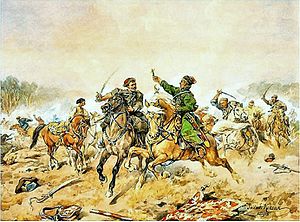Russo-Polish War (1654–1667)
| Russo-Polish War (1654–1667) | |||||||
|---|---|---|---|---|---|---|---|
 Jan Chryzostom Pasek in the Battle of Lachowicze (1660), a Juliusz Kossak painting. |
|||||||
|
|||||||
| Belligerents | |||||||
|
|
|
||||||
| Commanders and leaders | |||||||
|
Aleksey Trubetskoy, Bohdan Khmelnytsky, Yurii Khmelnytsky, Vasily Sheremetev, Vasiliy Buturlin, Ivan Khovansky, , |
Stefan Czarniecki, Wincenty Gosiewski, John II Casimir, Stanisław Lanckoroński, Jerzy Sebastian Lubomirski, Michał Kazimierz Pac, Aleksander Hilary Połubiński, , Janusz Radziwiłł, Paweł Jan Sapieha, Ivan Vyhovsky, Pavlo Teteria, Petro Doroshenko |
||||||
The Russo-Polish War of 1654–1667, also called Thirteen Years' War,First Northern War, or the War for Ukraine, was a major conflict between Tsardom of Russia and the Polish-Lithuanian Commonwealth. Between 1655 and 1660, the Second Northern War was also fought in the Polish-Lithuanian Commonwealth, thus this period became known in Poland as "The Deluge". The Commonwealth initially suffered defeats, but regained its ground and won most of the battles. However its plundered economy was not able to fund the long conflict. Facing internal crisis and civil war, Poland was forced to sign a truce. The war ended with significant Russian territorial gains and marked the beginning of the rise of Russia as a great power in Eastern Europe.
The conflict was triggered by the Khmelnytsky Rebellion of Zaporozhian Cossacks against the Polish-Lithuanian Commonwealth. The Cossack leader, Bohdan Khmelnytsky, derived his main foreign support from Alexis of Russia and promised his allegiance in recompense. Although the Zemsky Sobor of 1651 was poised to accept the Cossacks into the Moscow sphere of influence and to enter the war against Poland-Lithuania on their side, the Tsar waited until 1653, when a new popular assembly eventually authorized the protectorate of Ukraine with Tsardom of Russia. After the Cossacks ratified this agreement at the Pereyaslav Council the Russo-Polish War became inevitable.
In July 1654 the Russian army of 41,000 (nominally under the Tsar, but in fact commanded by Princes , Nikita Odoevsky and Ivan Khovansky) captured the border forts of Bely and Dorogobuzh and laid siege to Smolensk.
...
Wikipedia
